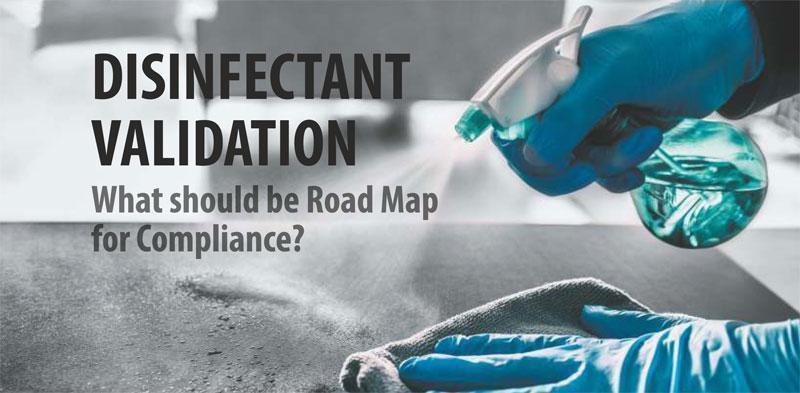
A documented and approved disinfection programme must be designed, validated, and implemented as part of any pharmaceutical manufacturing area certification. Because it is such an important aspect of any manufacturing facility’s maintenance plan, there is a lot of regulatory attention in this sector.
Observations concerning disinfectant validation studies and disinfectant procedures are routinely made by the US FDA, MHRA (Medicines and Healthcare Products Regulatory Agency), HPRA (Health Products Regulatory Authority), and CFDA (China Food and Drug Administration), among others.
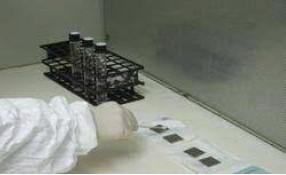 “Each company must have a systematic programme managing the qualilifation, use, and disposal of disinfectants,” according to the US FDA Guidance for Industry, Sterile Drug Products Produced by Aseptic Processing (Aseptic Processing Guide September 2004)—. The current United States Pharmacopeia, Chapter <1072> , provides some recommendations on disinfectant selection, use, and qualification, Without a doubt, pharmaceutical businesses must demonstrate that their room decontamination systems achieve and maintain the required levels of contamination control. This article will discuss considerations and best practises for verifying disinfectants used in medicine manufacturing settings.
“Each company must have a systematic programme managing the qualilifation, use, and disposal of disinfectants,” according to the US FDA Guidance for Industry, Sterile Drug Products Produced by Aseptic Processing (Aseptic Processing Guide September 2004)—. The current United States Pharmacopeia, Chapter <1072> , provides some recommendations on disinfectant selection, use, and qualification, Without a doubt, pharmaceutical businesses must demonstrate that their room decontamination systems achieve and maintain the required levels of contamination control. This article will discuss considerations and best practises for verifying disinfectants used in medicine manufacturing settings.
It’s crucial to note that disinfectant validation is a three-part process.
These components are:
· Disinfectant qualification (in vitro),
· In situ qualification
· Environmental monitoring with
trending during routine operation activities Studies that are conducted in a laboratory or articial setting are known as in vitro (Latin means “in glass”)[3]. Because a variety of factors might inuence disinfection effectiveness in real-world situations, it’s critical to undertake in vitro tests to show that a product is intrinsically effective against a certain organism under wellde ned settings like concentration and contact time. In order to register and market a disinfection or sporicidal product, most nations require in vitro testing. The product labelling reects the precise organisms (e.g., American Type and Culture Collection or ATCC strains) used in these experiments, as well as the testing circumstances (e.g. temperature, concentration, contact time, etc.). The testing required for product registration, on the other hand, frequently does not suit the needs of pharmaceutical companies who must meet regulatory requirements.
Disinfectant validation should be viewed as a form of process validation and is a much more indepth and extended process. It is often site or facility specifc. In summary:
“Disinfectant validation is the documented verification and implementation of procedures that have been shown to consistently control the range and levels of micro-organisms that may be encountered on the surfaces in a facility”[4].
What regulatory is expecting from industry
Effectiveness of disinfectants on construction materials that are being used for actual manufacturing surfaces (e.g. epoxy flooring, glass, PVC, aluminium, panel surface, etc.), should demonstrate effectiveness against environmental isolates, and demonstrating effectiveness when applied in accordance with the validation protocol or pharmacopeia, such as use dilution, contact time, prepared-solution expiration dating, soil load, application techniques used and so on.
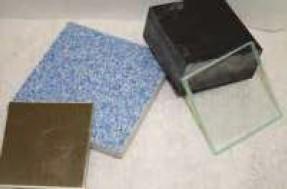 For a variety of reasons, including disinfectant reactivity, porosity, and other factors, the state and composition of the surface might have a negative impact on disinfection performance [5]. Letter of Warning dated April 23, 2019: ” You failed to demonstrate that your cleaning and disinfection practices are adequate to remove contaminants from equipment you use to manufacture your (b)(4) drug products. Your determination of the adequacy of your cleaning and disinfection process is limited to a visual examination of the surfaces to detect any contaminants”[6] .
For a variety of reasons, including disinfectant reactivity, porosity, and other factors, the state and composition of the surface might have a negative impact on disinfection performance [5]. Letter of Warning dated April 23, 2019: ” You failed to demonstrate that your cleaning and disinfection practices are adequate to remove contaminants from equipment you use to manufacture your (b)(4) drug products. Your determination of the adequacy of your cleaning and disinfection process is limited to a visual examination of the surfaces to detect any contaminants”[6] .
Environmental isolates are particularly interesting because they were isolated from the manufacturing environment, implying that they are being brought into the facility on a regular basis and so may constitute a risk to the product. Environmental isolates have been expected to be included in validation studies by pharmaceutical companies since the early 1990s.
“Characterization of recovered microorganisms provides vital information for the environmental monitoring program. 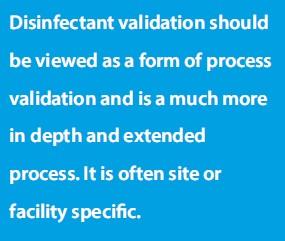
Environmental isolates often correlate with the contaminants found in a media fill or product sterility testing failure, and the overall environmental picture provides valuable information for an investigation” [1].
Specific details for disinfectant preparation (e.g., use-dilution concentration, water quality, water temperature, sterilization method etc.), required wet contact time for the surface, application devices and instructions (e.g., mopping direction and room grid), and expiry dates for both the use-dilution and the opened source container of disinfectant or sporicidal should all be included in SOPs.
FDA Warning Letter October 31, 2008, “However your response to our FDA-483 is inadequate because the following were not addressed: Effectiveness of solution at the dilution used, and 2) effectiveness of throughout the shelf life (up to the expiry date).”
In vitro testing
When investigating a variety of prospective disinfectants or sporicidal treatments in vitro, it’s a good idea to start with suspension experiments. In its most basic form, a suspension study is exposing a known inoculum of a certain organism to a known disinfectant or sporicidal, for example, for a set amount of time. This form of evaluation provides a quick indication of whether a product and/or set of application conditions (e.g., water quality, temperature, use dilution, contact time) are efficient against a specific organism or group of organisms. Following the completion of the suspension trials, a comparison of the efficacy of various products should allow for the selection of a small number of highly effective products that can then be subjected to more rigorous testing, including coupon studies.
Coupon trials have been the subject of a number of recent FDA Warning Letters. Regulators are particularly concerned that the MOC selection and condition do not accurately reflect both the real
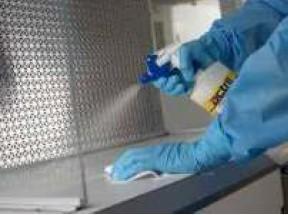 MOC and the state of such materials in production regions. “All surfaces used in essential processing and manufacturing areas were not assessed,” according to a recent FDA warning letter. (January 29, 2013 FDA Warning Letter) “On about 15 distinct hard surfaces (e.g.Aluminium) found in classified areas used to manufacture sterile products, there is no examination of the effectiveness of cleaning and chemical agents used to suppress microbial populations.” (November 1, 2013; GMP Trends).
MOC and the state of such materials in production regions. “All surfaces used in essential processing and manufacturing areas were not assessed,” according to a recent FDA warning letter. (January 29, 2013 FDA Warning Letter) “On about 15 distinct hard surfaces (e.g.Aluminium) found in classified areas used to manufacture sterile products, there is no examination of the effectiveness of cleaning and chemical agents used to suppress microbial populations.” (November 1, 2013; GMP Trends).
Aside from the MOC and the state of the coupons, choosing which environmental isolates to test is important. Organisms most commonly isolated from manufacturing surfaces and personnel (e.g. gramme positive and gramme negative bacteria), organisms known to show resistance to decontamination or other harsh conditions (e.g. spore- formers, mould), and organisms introduced into the area via known vectors, such as raw materials, water samples, personal monitoring, environmental monitoring, should all be included in the selection. If a facility is freshly
operating and a large body of isolates has yet to be developed, a broad spectrum of organisms acquired from ATCC, for example, may be considered.
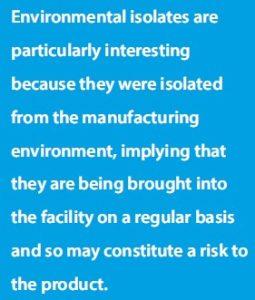 Regulators will examine additional parts of the in vitro study, such as log reduction targets and results, recovery and neutralisation tests, and controls, in addition to MOC and isolate selection. “Your disinfectant qualification for (b)(4) and (b)(4) bi-spore disinfectants documented that the log reduction criteria (Bacteria 4, Fungi 3) was not met when tested with numerous organisms in a range of surfaces,” according to a recent FDA Warning Letter. (October 7, 2011 FDA Warning Letter). “There is no guarantee that the disinfectant is effective against mould because it failed to fulfil your established recovery rate acceptance threshold in the “Disinfectant Validation and Efficacy Research by the Surface Test Method” study in December 2001.” (May 24, 2007 FDA Warning letter)
Regulators will examine additional parts of the in vitro study, such as log reduction targets and results, recovery and neutralisation tests, and controls, in addition to MOC and isolate selection. “Your disinfectant qualification for (b)(4) and (b)(4) bi-spore disinfectants documented that the log reduction criteria (Bacteria 4, Fungi 3) was not met when tested with numerous organisms in a range of surfaces,” according to a recent FDA Warning Letter. (October 7, 2011 FDA Warning Letter). “There is no guarantee that the disinfectant is effective against mould because it failed to fulfil your established recovery rate acceptance threshold in the “Disinfectant Validation and Efficacy Research by the Surface Test Method” study in December 2001.” (May 24, 2007 FDA Warning letter)
In situ testing
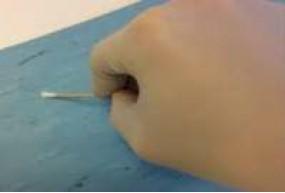 In situ (Latin meaning “on site” or “in position) testing shows that the disinfection or sporicidal agent, in combination with the facilities and personnel’ preparation and application methods, is successful at maintaining the environmental bacteria levels deemed required for the target product’s production.
In situ (Latin meaning “on site” or “in position) testing shows that the disinfection or sporicidal agent, in combination with the facilities and personnel’ preparation and application methods, is successful at maintaining the environmental bacteria levels deemed required for the target product’s production.
The disinfection program’s effectiveness is proved by analysing environmental monitoring data
over time and during “worst-case” remedial events. Many companies, for example, may compare environmental data before and after a preventative maintenance shutdown, when the room is more likely to indicate relatively high levels of environmental pollution. As evidenced by regulatory feedback, “There is a lack of written procedures assigning responsibility, providing cleaning schedules, and describing in sufficient detail the method, equipment, and materials to be used for sanitation,” it is critical that the procedures used to decontaminate the area during the in-situ evaluation reflect the written SOPs. Your company, in particular, lacks established and approved procedures for cleaning and disinfecting equipment and materials.” (FDA 483, 11 June 2013) Clearly, the individuals who are assigned to carry out these tasks must get adequate training and supervision. The most common FDA 483 observations are failure to have and/or follow written processes, difficulties with cleaning, sanitization, and maintenance, and failure to offer enough training.
 “To demonstrate the efficacy of a disinfectant within a pharmaceutical manufacturing environment, it may be necessary to conduct the following tests…a statistical comparison of the frequency of isolation and the numbers of microorganisms isolated before and after the implementation of a new disinfectant,” according to USP chapter <1072>. “The efficiency of th
“To demonstrate the efficacy of a disinfectant within a pharmaceutical manufacturing environment, it may be necessary to conduct the following tests…a statistical comparison of the frequency of isolation and the numbers of microorganisms isolated before and after the implementation of a new disinfectant,” according to USP chapter <1072>. “The efficiency of th
ese sanitization techniques should be judged by their ability to assure that potential
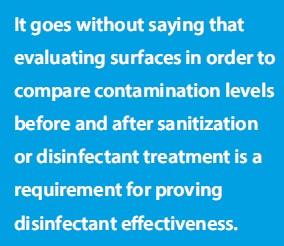
contaminants are adequately removed from surfaces (i.e., via acquiring samples before
and after sanitization),” according to the FDA Aseptic Processing Guide from 2004. It goes without saying that evaluating surfaces in order to compare contamination levels before and after sanitization or disinfectant treatment is a requirement for proving disinfectant effectiveness.
Acceptance Criteria (Disinfectants Efficacy Test):
 For contact time establishment there should be minimum 5 log reduction for vegetative bacteria/yeastand 3 log reduction for bacteria spore/fungi (Mold) with a control disinfectant and sanitizing
For contact time establishment there should be minimum 5 log reduction for vegetative bacteria/yeastand 3 log reduction for bacteria spore/fungi (Mold) with a control disinfectant and sanitizing - For surface coupons studies there should be minimum 3 log reduction for vegetative bacteria/yeastand 2 log reduction for bacteria spore/fungi (Mold) with a control disinfectant application.
- The 2-day hold time study disinfectant in use studies for established contact time should show 5 log reduction for vegetative bacteria/ yeast and 3 log reduction for bacterial spore/fungi (Mold) witha control disinfectant and sanitizingagents
- There should not be any microbial growth in store disinfectant to establish with selected hold time period.
Environmental monitoring and trending
Environmental monitoring techniques, such as frequency, location, and number of samples per sampling interval, should be based on the most up-to-date guideline documents and a scientific justification that is appropriate for the product being created. However, a single day’s
Summary
In vitro studies demonstrate how effective the disinfectant or sporicidal agent is under highly controlled conditions; in situ evaluations demonstrate how effective the disinfectant or sporicidal agent is under actual use conditions (typically conducted in a worst-case scenario); and routine environmental monitoring with trending and assessment of
worth of environmental monitoring data is only a snapshot in time, and it can’t provide much helpful information about an industrial area’s state of control on its own.
The effectiveness of a holistic pollution management programme is further validated by ongoing environmental monitoring with data trends. Any organisms found should be identified to the species level and kept for use in future in vitro experiments. Data should be checked on a regular basis to look for undesirable trends; once a month is a good starting point.
negative trends are all part of disinfectant validation. While there is no single regulatory or advisory document that serves as a blueprint for developing a disinfectant validation study, there are a number of documents and references, such as FDA 483 observations and Warning Letters that both highlight pitfalls and provide valuable insight into study design. In addition, criteria for detecting a negative trend must be specified.
Dr. Tarun Chugh is expert in Quality System, Analytical, and Regulatory subjects, having 32+ years of experience working for reputed Indian and MNC pharma companies globally. Currently serving as a consultant to a number of Indian and international companies, he has experience of conducting quality audits, preparing organizations for inspections, coordinating as well as supporting cGMP inspections and approvals of manufacturing facilities. Also conducts due diligence for acquisitions and strategic alliances. Clients include companies based in India, China, EU, Bangladesh, Canada, US, KSA and many others.
References:
[1] “Sterile Drug Products Produced by Aseptic Processing — Current Good Manufacturing Practice,” 2004, Accessed:
Jan. 23, 2022. [Online]. Available: http://www.fda.gov/cder/guidance/index.htm or
http://www.fda.gov/cber/guidelines.htm.
[2] USP <1072>, DISINFECTANTS AND ANTISEPTICS, vol. 42. USP, 2019.
[3] “In vitro – Wikipedia.” https://en.wikipedia.org/wiki/In_vitro
[4] “Disinfectant validation – European Pharmaceutical Review.”
https://www.europeanpharmaceuticalreview.com/article/1189/disinfectant-validation/
[5] “Efficacy | Disinfection & Sterilization Guidelines | Guidelines Library | Infection Control | CDC.”
https://www.cdc.gov/infectioncontrol/guidelines/disinfection/efficacy.html
[6] “Laboratoires Clarins – 568157 – 04/23/2019 | FDA.” https://www.fda.gov/inspections-compliance-enforcement-andcriminal-
investigations/warning-letters/laboratoires-clarins-568157-04232019
[7] “In situ – Wikipedia.” https://en.wikipedia.org/wiki/In_situ (accessed Jan. 23, 2022).
[8] “CFR – Code of Federal Regulations Title 21,” Accessed: Jan. 23, 2022. [Online]. Available:
https://www.accessdata.fda.gov/scripts/cdrh/cfdocs/cfcfr/CFRSearch.cfm?fr=211.56.
[9] Dr. Tarun Chugh and Dr. Apar Dholakia, “Environmental Monitoring in Aseptic Processing Area, Dec 2020 – Jan 2021
Edition by Pharma Machines – Issue,” 2021. https://issuu.com/pharma.machines/docs/dec_2020_-
_jan_2021?fr=sOGRmZjEyMDg4MjQ
Exclusive







